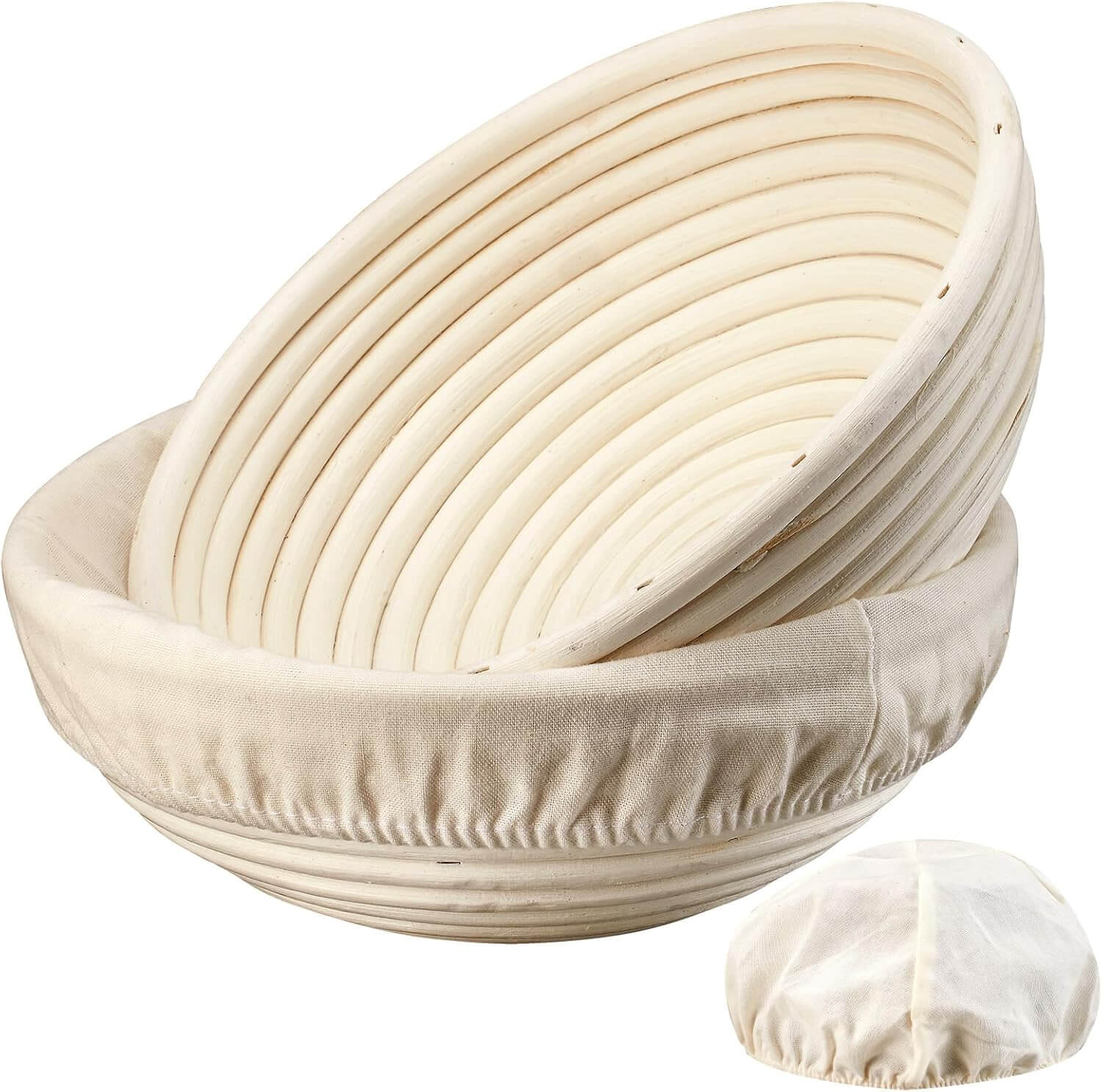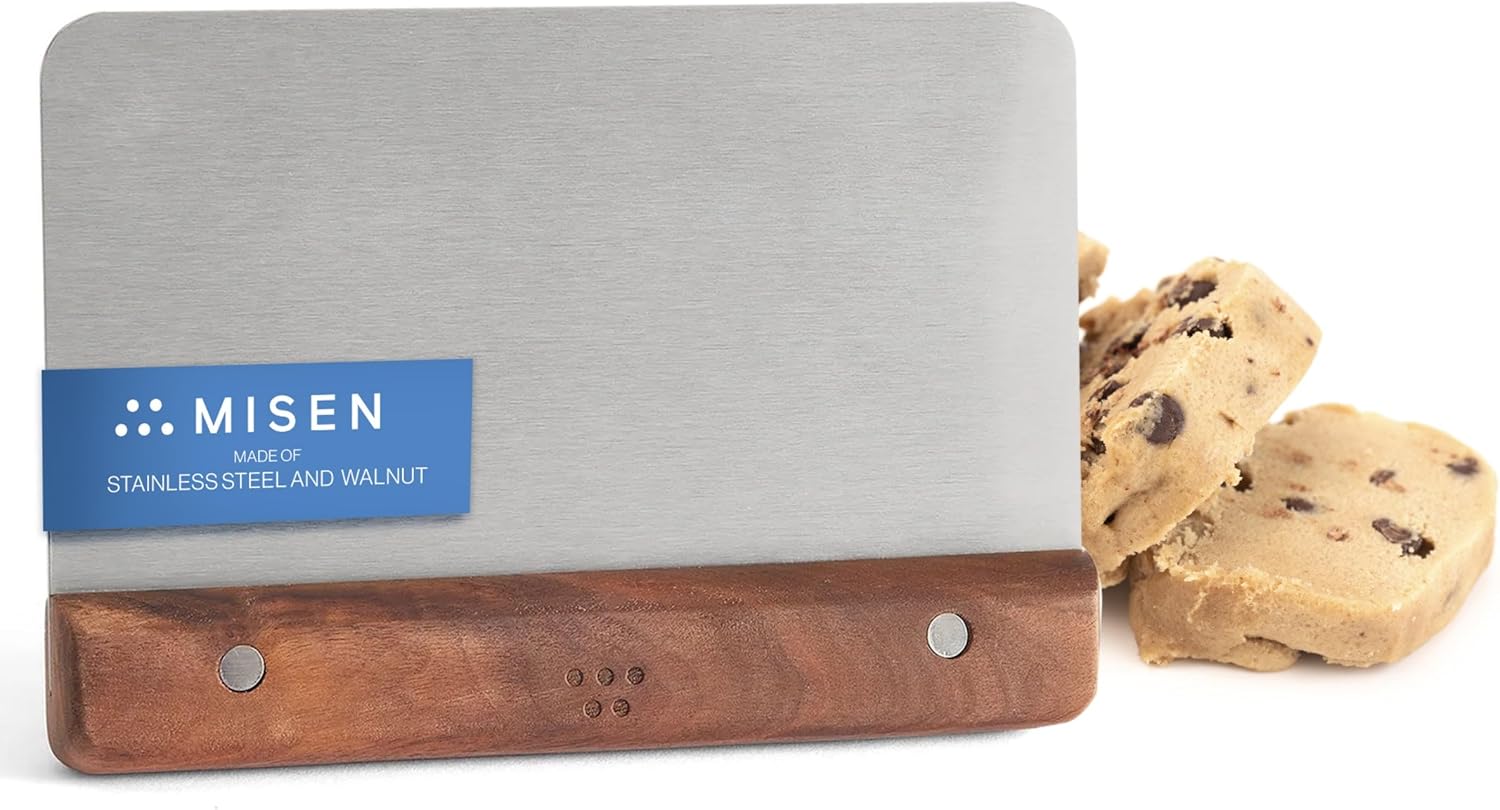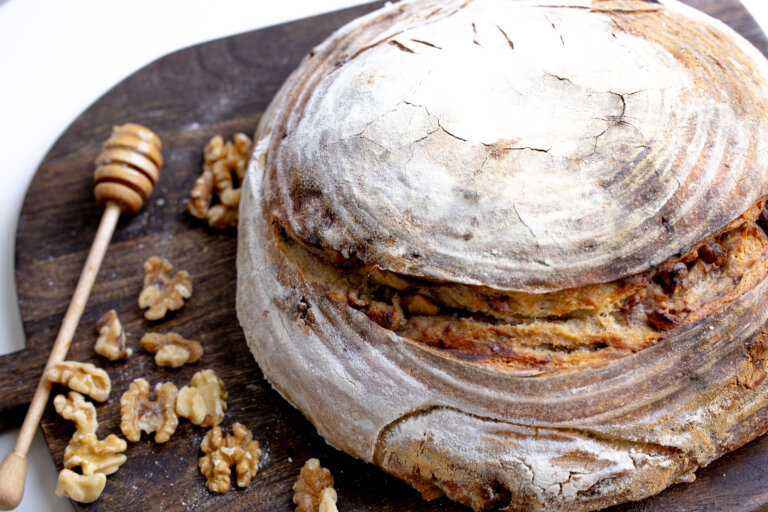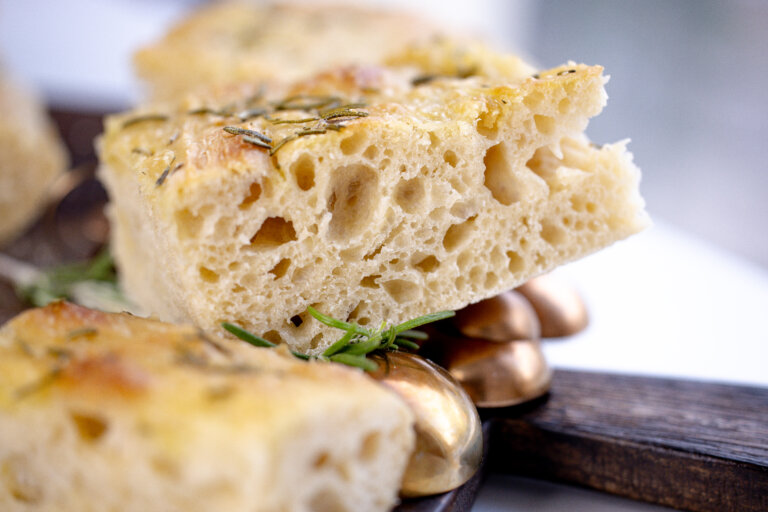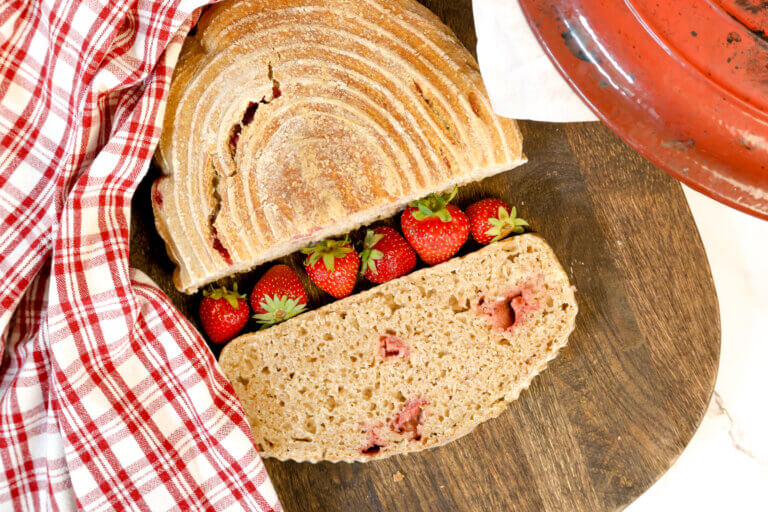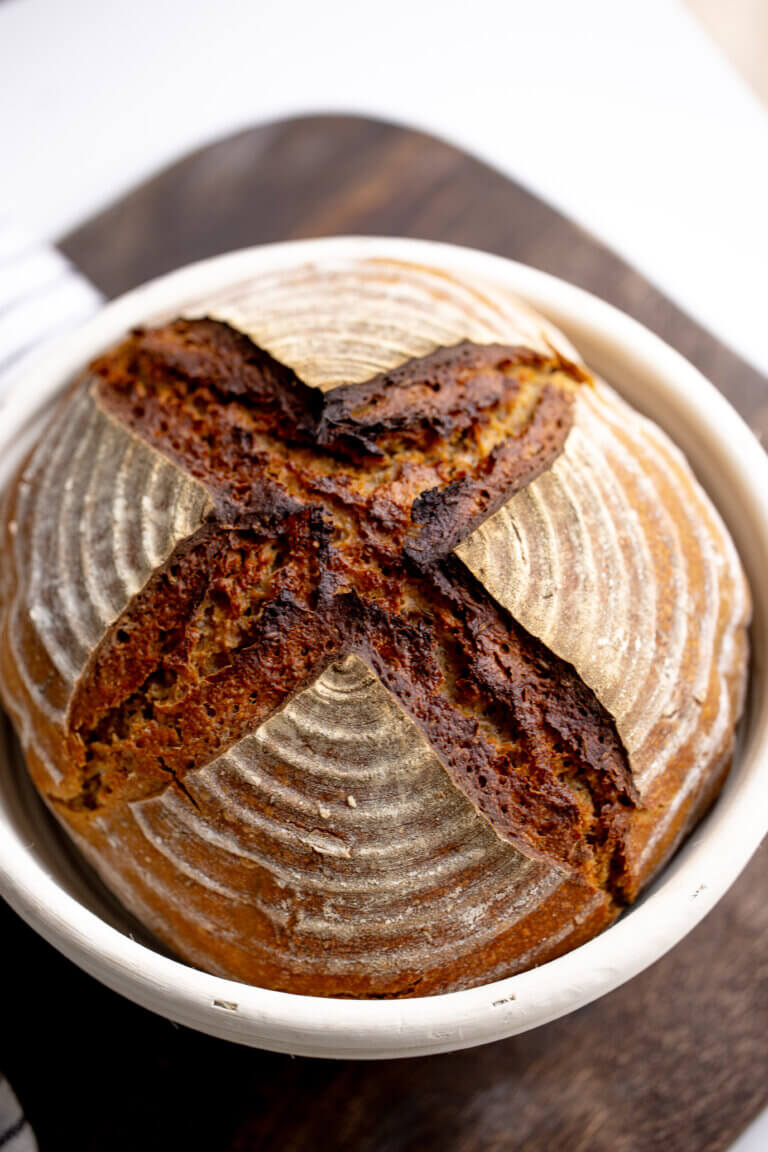Rosemary Olive Oil Sourdough Bread
Fragrant rosemary garlic sourdough bread with olive oil. Easy recipe for a flavorful Italian-inspired loaf, perfect with soup or pasta!
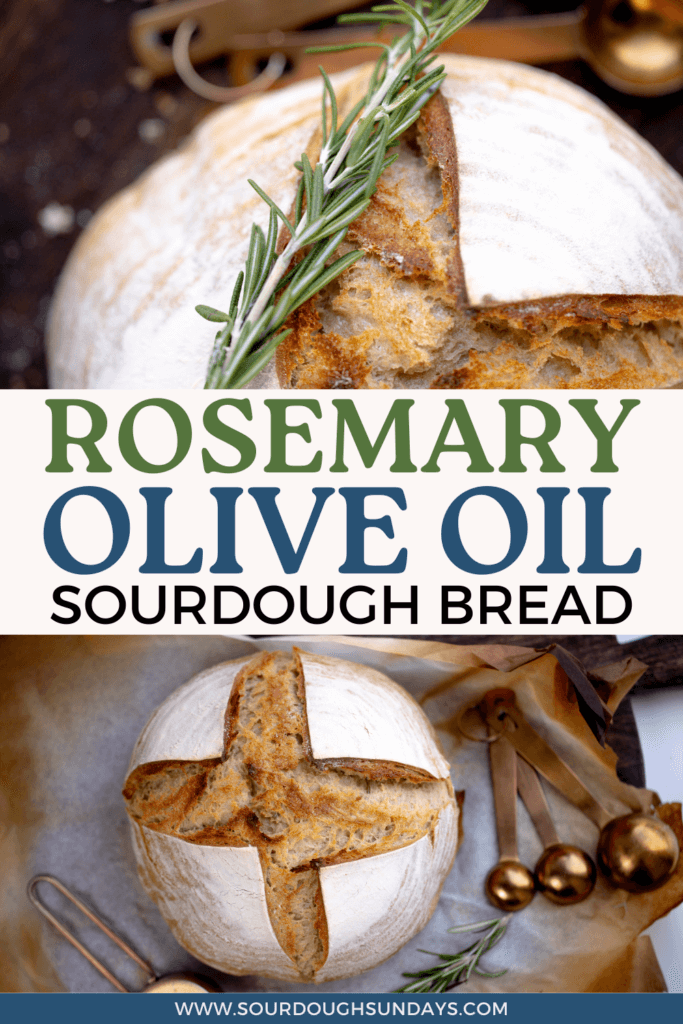
This sourdough rosemary olive recipe has become one of my favorite twists on my classic Sourdough Bread Recipe. It’s my go-to when I want to treat friends stopping by or unwind with my loved ones after a long week. The fragrant rosemary and lush olive oil bring an Italian flair that’s irresistible, especially paired with a hearty bowl of soup or pasta.
Why You’ll Love This Recipe:
- Fragrant, Tuscan-Inspired Flavors: Freshly chopped rosemary and rich extra virgin olive oil are kneaded right into the dough, creating a loaf that bursts with earthy, Italian warmth. It’s the perfect companion for a cozy night in with pasta or a hearty soup.
- Perfect Crust and Crumb: Enjoy a crisp, golden crust with a soft, chewy interior – just what you want in any loaf of artisanal sourdough bread.
- Simple & Whole Food Ingredients: What could be simpler than combining sourdough starter, water, salt and some fresh garlic and rosemary? I love how simple the ingredients for making delicious this rosemary sourdough bread.
Ingredients
Flour – my favorite to use is organic spelt bread flour, but organic all-purpose flour will work well too.
Sourdough Starter – use active sourdough starter, that has been fed no more than 6 hours ago, doubled in size and is bubbly. If you down have your own starter, Here is my simple step by step guide on how to make it from scratch
Salt – unrefined sea salt is best
Water – Use lukewarm, filtered water. Avoid hot water, or water directly from the tap.
Olive Oil – I prefer to use Virgin Olive oil for the best quality and taste
Rosemary – use fresh rosemary that is finely chopped
** Head to the recipe card at the bottom of the page for exact measurements.
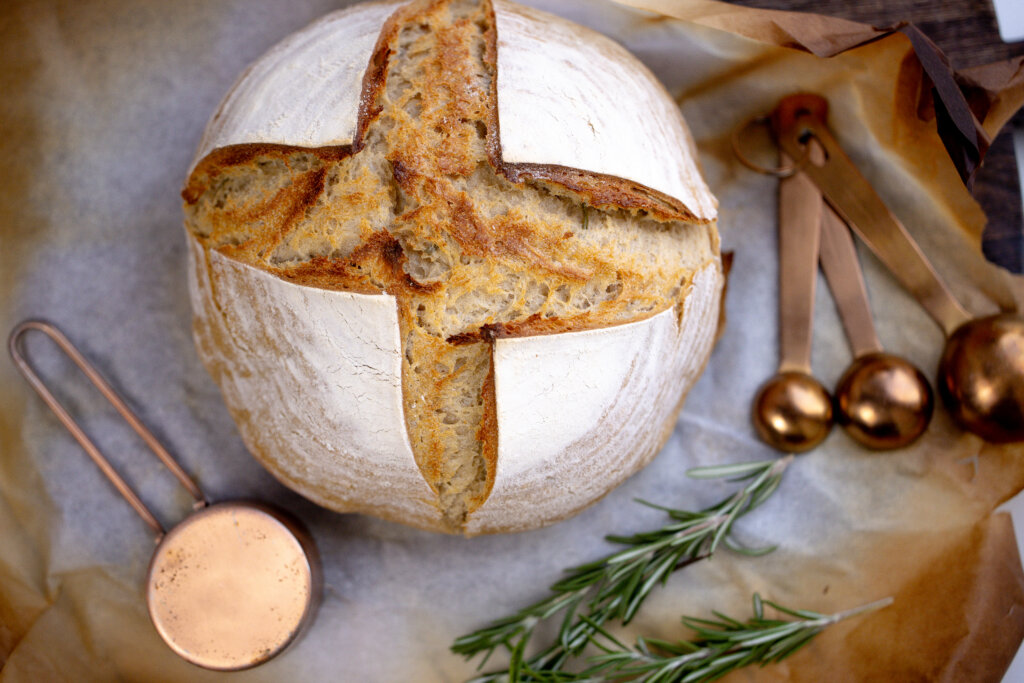
Supplies
- Large Mixing Bowl
- Measuring Cups and Spoons or Kitchen Scale
- Wooden Spoon or Spatula
- Kitchen Aid
- Sandwich Bread Loaf Pan
- Banneton
- Bench Scraper
- Proofing Box
- Bread Lame
Baker’s Schedule #1: Overnight Rise
Goal: Fresh rosemary sourdough for brunch or lunch
Total Time: ~20–24 hours
DAY 1 – Morning
8:00 AM – Mix all ingredients and knead (10–15 min in stand mixer).
8:30 AM – Transfer to oiled bowl. Cover and bulk ferment at 27°C (80°F) for 5–7 hours until doubled.
DAY 1 – Afternoon
2:30 PM – Divide and shape dough into two loaves.
3:00 PM – Place in floured bannetons, cover, and refrigerate overnight.
DAY 2 – Next Morning
8:00 AM – Preheat oven with Dutch oven inside at 250°C (500°F) for 1 hour.
9:00 AM – Score and bake one loaf: 20 mins covered, then 15–20 mins uncovered at 235°C (450°F).
Cool before slicing.
Baker’s Schedule #2: Same-Day Bake (Early Start)
Goal: Fresh rosemary sourdough by dinner
Total Time: ~12–14 hours
DAY 1
6:30 AM – Mix dough and knead in stand mixer.
7:00 AM – Transfer to oiled bowl. Bulk ferment at 27°C (80°F) for 5–7 hours.
DAY 1 – Afternoon
1:00 PM – Divide and shape. Place in floured bannetons.
1:30 PM – Final proof at room temp for 1.5–2 hours.
DAY 1 – Late Afternoon
3:00 PM – Preheat oven to 250°C (500°F) with Dutch oven inside.
4:00 PM – Score and bake: 20 mins covered, then 15–20 mins uncovered at 235°C (450°F).
Cool and serve by dinner.
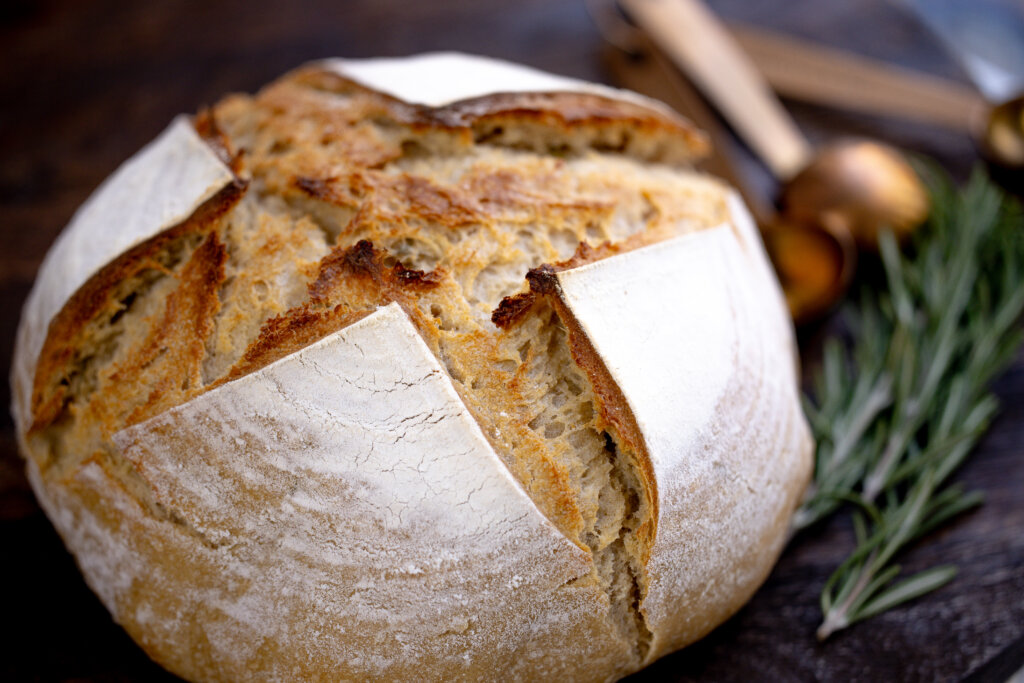
Instructions
- Mix all ingredients in the bowl of a standing mixer.
- With the dough hook attached, kneed for 10-15 minutes. You will know your dough is ready when it’s soft, supple & stretchable.
- Form into a smooth ball, and transfer to an oiled large bowl & cover bowl with plastic wrap or damp towel.
- Let rise in a warm place – preferably a fermentation box, set to 27 degrees C (80 degrees F) for 5-7 hours.
- Check periodically to see how well the bread has risen.
- When the dough has doubled, turn it out onto a lightly floured work surface.
- Divide into two using a dough scraper. Let the other half of the dough rest while you work the first.
- Fold the dough onto itself, then pull out the edges and fold them in. Lastly, spin the loaf towards you to create surface tension and final shape.
- Place in a floured banneton or proofing basket seam side up. Use rice flour for coating the banneton baskets for best results.
- Place the banneton basket with your dough inside into a big plastic bag, tie it off, and place it in the fridge for the final rise.
- Leave loaves in the fridge overnight.
- Next day, place your Dutch oven into the oven and preheat for an hour at 250C (500F).
- When the oven is preheated, turn one banneton basket out onto a large piece of baking parchment
- Now the fun part! Score the top of the dough using a sharp knife, razor blade or a bread lame.
- Carefully lift the baking parchment with your loaf and place it inside the preheated Dutch oven.
- Bake for 20 minutes with the lid on.
- Lower the temperature to 235C (450f), remove the lid, and bake for another 15-20mins uncovered.
- Carefully remove the hot Dutch oven from your oven, and using the baking parchment take the loaf out.
- Allow the rosemary sourdough bread to cool on a wire rack
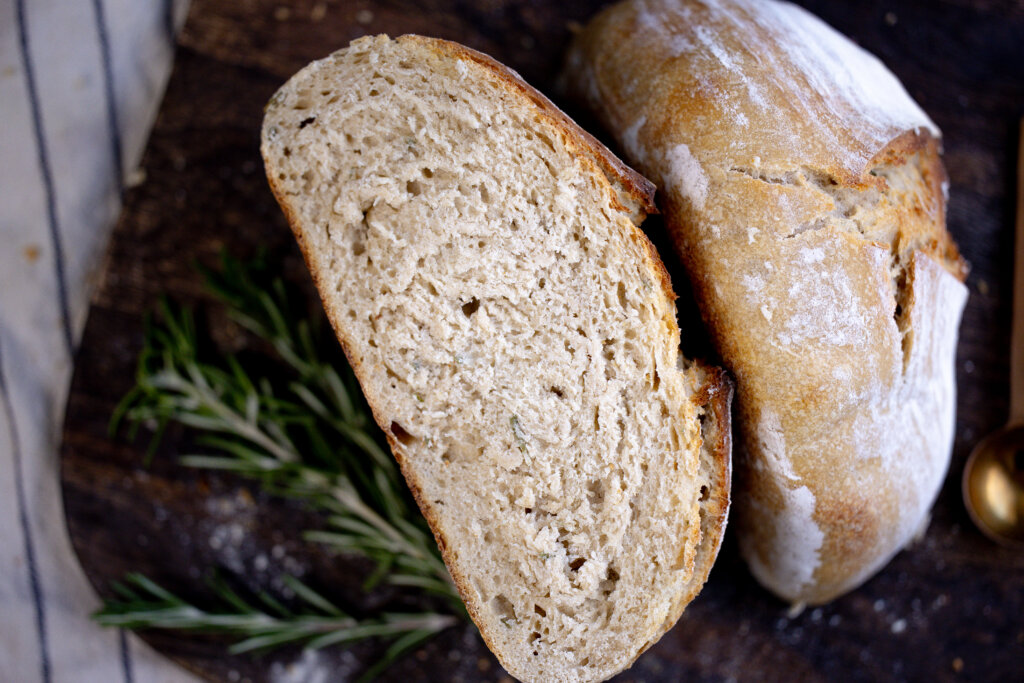
Tips for Making Rosemary Sourdough Bread
- Starter Vitality: Use a lively, bubbly sourdough starter that’s been fed 6-8 hours prior. A float test (a spoonful floats in water) ensures it’s strong enough for a robust rise. (LINK TO STARTER POST)
- Kneading Precision: Knead until the dough passes the windowpane test—stretch a small piece until it’s thin and translucent without tearing. This ensures a chewy, well-structured crumb.
- Warm Rise Environment: Maintain a consistent 80°F (27°C) for the 5-7 hour bulk rise. If you don’t have a proofing box, place the bowl in an off oven with the light on or near a warm radiator.
- Rosemary Distribution: Chop rosemary finely and mix thoroughly to spread the flavor evenly. If using dried rosemary, reduce to 1.5 tbsp, as it’s more potent.
- Scoring Confidence: Score deeply (1/4-1/2 inch) with a lame to control the loaf’s expansion. Simple slashes or a single long cut work well for beginners.
- Steam for Crust: The Dutch oven creates steam, but for an extra crispy crust, spritz the dough lightly with water just before placing it in the oven.
- Cooling Patience: Let the bread cool for at least 1 hour before slicing. Cutting too soon can result in a gummy texture due to trapped steam.
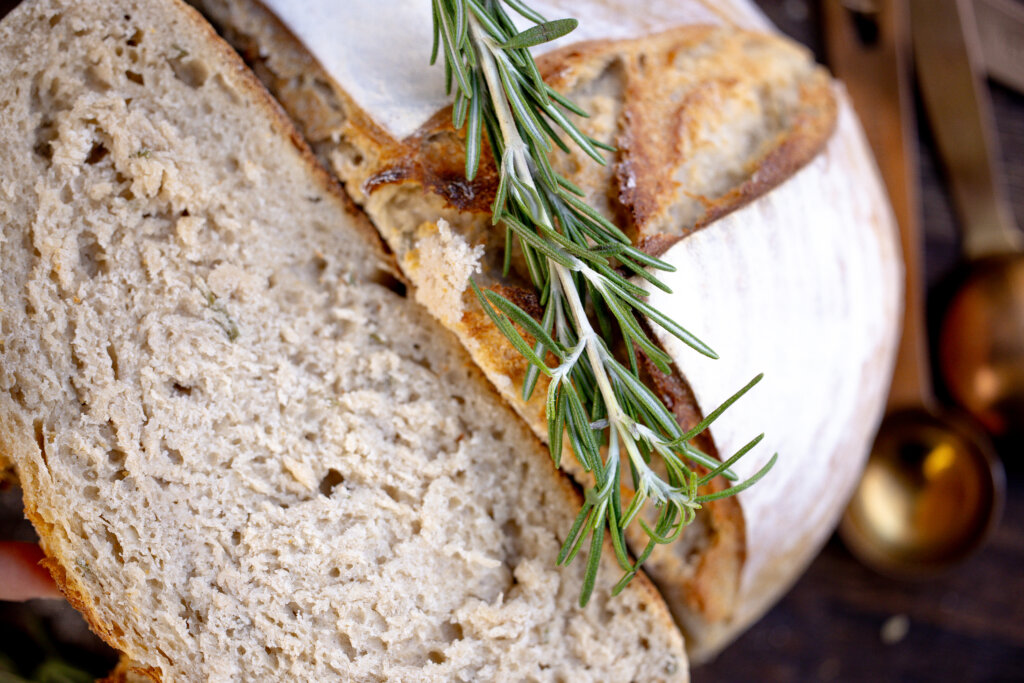
Storage
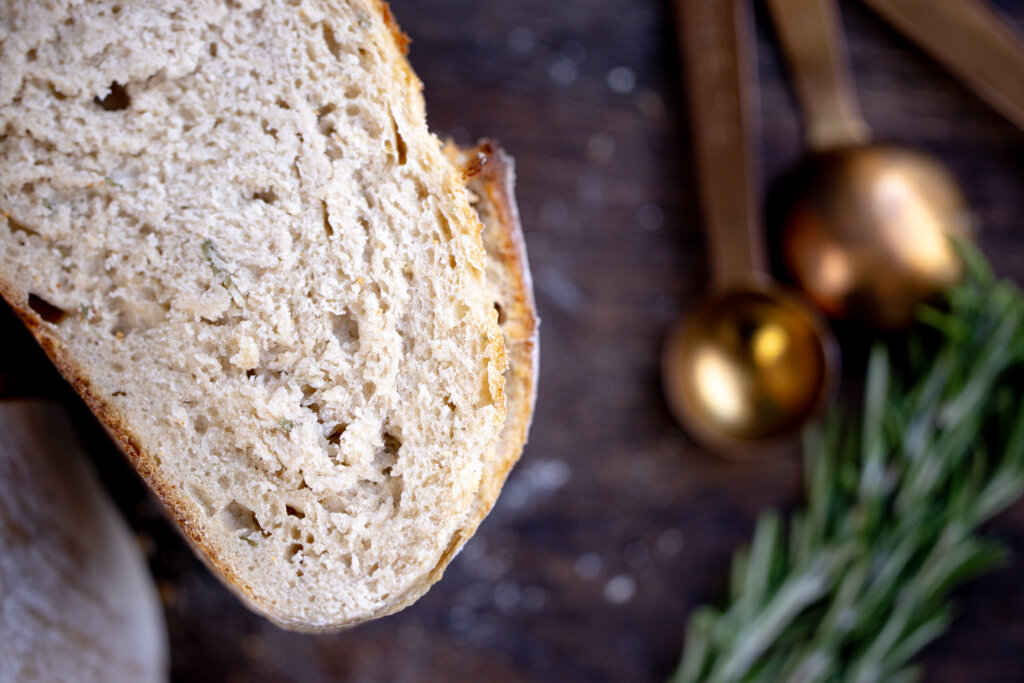
FAQs
Rosemary Olive Oil Sourdough Bread
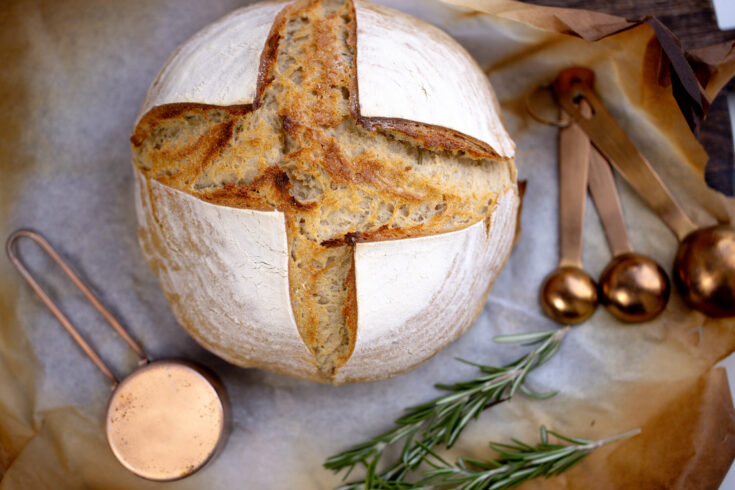
Fragrant rosemary garlic sourdough bread with olive oil. Easy recipe for a flavorful Italian-inspired loaf, perfect with soup or pasta!
Ingredients
- 200g active sourdough starter
- 950g all purpose spelt flour (or bread flour)
- 3 tbs (20g) salt
- 20g olive oil
- 450g water
- 3 tbs chopped fresh rosemary
Instructions
- Mix all ingredients in the bowl of a standing mixer.
- With the dough hook attached, kneed for 10-15 minutes. You will know your dough is ready when it’s soft, supple & stretchable.
- Form into a smooth ball, and transfer to an oiled large bowl & cover bowl with plastic wrap or damp towel.
- Let rise in a warm place – preferably a fermentation box, set to 27 degrees C (80 degrees F) for 5-7 hours.
- Check periodically to see how well the bread has risen.
- When the dough has doubled, turn it out onto a lightly floured work surface.
- Divide into two using a dough scraper. Let the other half of the dough rest while you work the first.
- Fold the dough onto itself, then pull out the edges and fold them in. Lastly, spin the loaf towards you to create surface tension and final shape.
- Place in a floured banneton or proofing basket seam side up. Use rice flour for coating the banneton baskets for best results.
- Place the banneton basket with your dough inside into a big plastic bag, tie it off, and place it in the fridge for the final rise.
- Leave loaves in the fridge overnight.
- Next day, place your Dutch oven into the oven and preheat for an hour at 250C (500F).
- When the oven is preheated, turn one banneton basket out onto a large piece of baking parchment
- Now the fun part! Score the top of the dough using a sharp knife, razor blade or a bread lame.
- Carefully lift the baking parchment with your loaf and place it inside the preheated Dutch oven.
- Bake for 20 minutes with the lid on.
- Lower the temperature to 235C (450f), remove the lid, and bake for another 15-20mins uncovered.
- Carefully remove the hot Dutch oven from your oven, and using the baking parchment take the loaf out.
- Allow the fermented sourdough bread recipe to cool on a wire rack
Notes
Tips
- Starter Vitality: Use a lively, bubbly sourdough starter that’s been fed 6-8 hours prior. A float test (a spoonful floats in water) ensures it’s strong enough for a robust rise. (LINK TO STARTER POST)
- Kneading Precision: Knead until the dough passes the windowpane test—stretch a small piece until it’s thin and translucent without tearing. This ensures a chewy, well-structured crumb.
- Warm Rise Environment: Maintain a consistent 80°F (27°C) for the 5-7 hour bulk rise. If you don’t have a proofing box, place the bowl in an off oven with the light on or near a warm radiator.
- Rosemary Distribution: Chop rosemary finely and mix thoroughly to spread the flavor evenly. If using dried rosemary, reduce to 1.5 tbsp, as it’s more potent.
- Scoring Confidence: Score deeply (1/4-1/2 inch) with a lame to control the loaf’s expansion. Simple slashes or a single long cut work well for beginners.
- Steam for Crust: The Dutch oven creates steam, but for an extra crispy crust, spritz the dough lightly with water just before placing it in the oven.
- Cooling Patience: Let the bread cool for at least 1 hour before slicing. Cutting too soon can result in a gummy texture due to trapped steam.
Storage
Room Temperature: Store cooled sourdough bread in a cloth bag or wrapped in a clean kitchen towel at room temperature for up to 3 days. This preserves the crust’s crispness and the crumb’s chewiness.
Refrigerator: Place in an airtight container or resealable bag and refrigerate for up to 7 days. The olive oil helps maintain moisture, but the crust may soften slightly. Slice before storing for convenience.
Freezer: Freeze for up to 3 months. Slice the loaf first, wrap each slice tightly in plastic wrap, and store in a freezer-safe bag. Whole loaves can be wrapped in plastic and foil to prevent freezer burn.
Reheating:
- From Room Temperature or Refrigerator: Preheat the oven to 325°F (160°C). Place slices or the whole loaf on a baking sheet and warm for 5-10 minutes to revive the crust. For a softer crumb, wrap in foil. Microwaving (15-20 seconds per slice) works but may soften the crust.
- From Freezer: Thaw slices at room temperature for 30-60 minutes or overnight in the fridge. Reheat in a 325°F (160°C) oven for 8-12 minutes, unwrapped, to restore crispness. Whole loaves may need 15-20 minutes after thawing.
Recommended Products
As an Amazon Associate and member of other affiliate programs, I earn from qualifying purchases.
Nutrition Information:
Yield:
12Serving Size:
1Amount Per Serving: Calories: 313Total Fat: 4gSaturated Fat: 1gTrans Fat: 0gUnsaturated Fat: 3gCholesterol: 0mgSodium: 8mgCarbohydrates: 62gFiber: 9gSugar: 5gProtein: 13g
The nutritional information provided on this site is an estimate and should not be considered a substitute for professional dietary advice.

